Get out your trimmers because it’s time to prune fruit trees this winter! It’s the perfect time to get them in tip-top shape before next year’s growing season.
Fruit trees are a wonderful addition to any property. There’s nothing like going out into your own backyard and picking a fresh, juicy ripe apple or pear and sinking your teeth into it.
When you envision healthy fruit trees, you likely picture perfectly shaped trees. Trees that have full, lush green foliage and bright fruit hanging off of each branch. However, over time, your fruit trees can get a little unruly or start to struggle to produce healthy fruit.
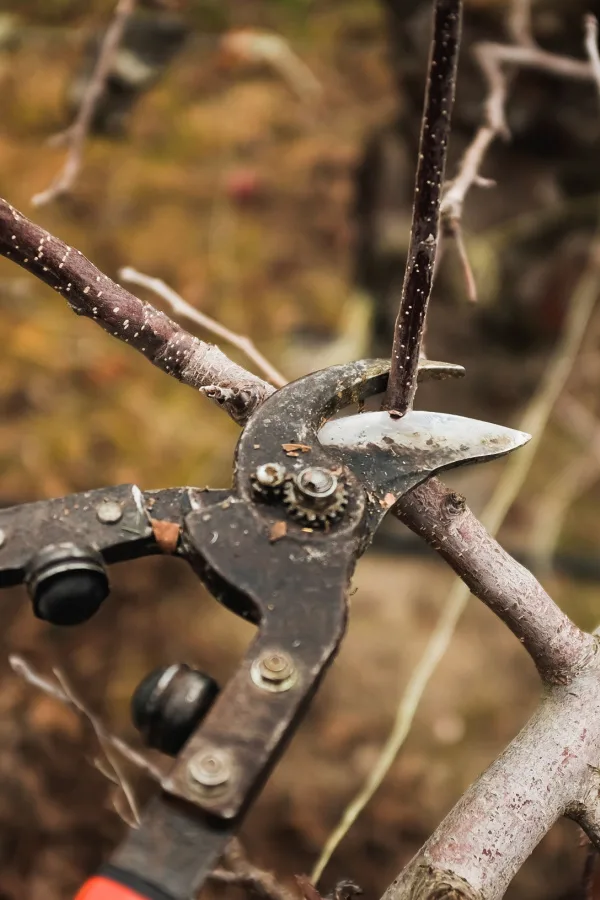
Maybe the branches are a bit too overcrowded or the tree is too large and difficult for you to harvest. Maybe you recently had some wind damage and have a few dead or broken branches.
Wherever the case, it’s likely your fruit trees are in need of a little bit of trimming. With a little bit of cold-weather work, you will set your fruit trees off to a perfect start when spring rolls around.
Advantages Of Winter Pruning
You can actually trim the fruit trees during the spring and summer months. However, the winter is actually the best time to do this simple chore.
One of the biggest reasons why is that it’s easier for you during this time. Yes, you might need to bundle up to stay warm enough to get the job done. But, you will have an easier time seeing what needs to be trimmed.
During the winter months, the fruit tree has dropped all of its leaves, leaving the branches exposed. You will have a much easier time making the proper cuts. It allows you to see which branches need to be trimmed back and which to leave alone without the leaves in the way.
Another advantage – and one that benefits the tree – is that fruit trees go dormant during the winter months. The trees are no longer creating new growth. Instead, they are conserving their energy and resources to start growing again when spring rolls around.
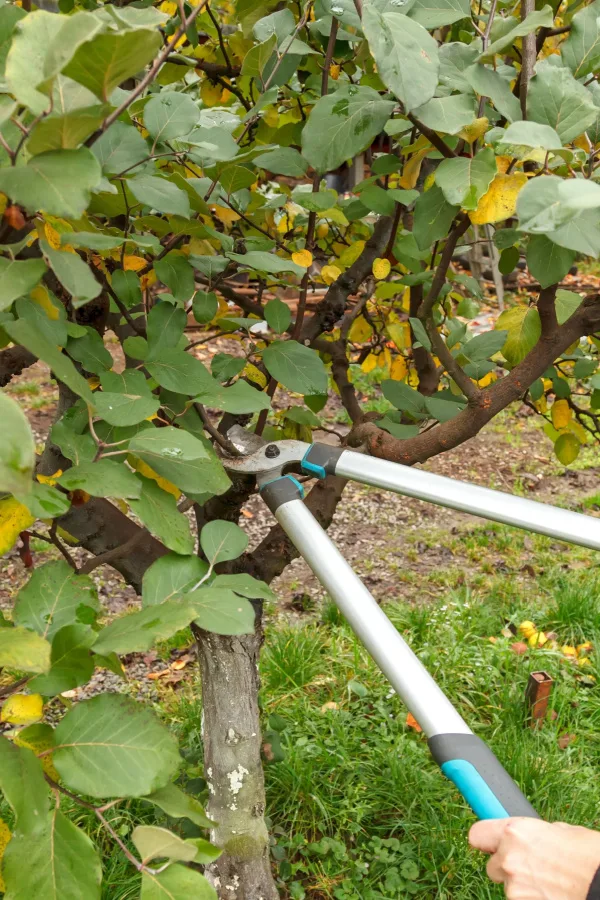
Pruning the fruit trees in the winter will create little to no stress for the tree. Once spring arrives, the tree can send its energy to the strongest, healthiest branches instead of distributing its resources all throughout each tiny branch and twig.
Pruning Fruit Trees In The Winter
Trees take a long time to grow and reach their mature heights. It might seem counterintuitive and daunting to remove some of that growth. However, when you prune in the winter, your tree will be better in the long run.
Pruning helps to remove dead or damaged branches. It also increases airflow to all parts of the tree and allows better sun absorption. It also helps keep the tree in a manageable shape. However, the task is a lot simpler than you think. This is especially true when you break it down into a few simple steps.
The Right Equipment
Before you begin pruning though, you want to make sure you have the right equipment. You will likely need a variety of different pruners and saws to get the job done properly.
Be sure to properly clean and sharpen your pruning blades before using them. You should disinfect them in between each tree to help avoid spreading possible diseases.
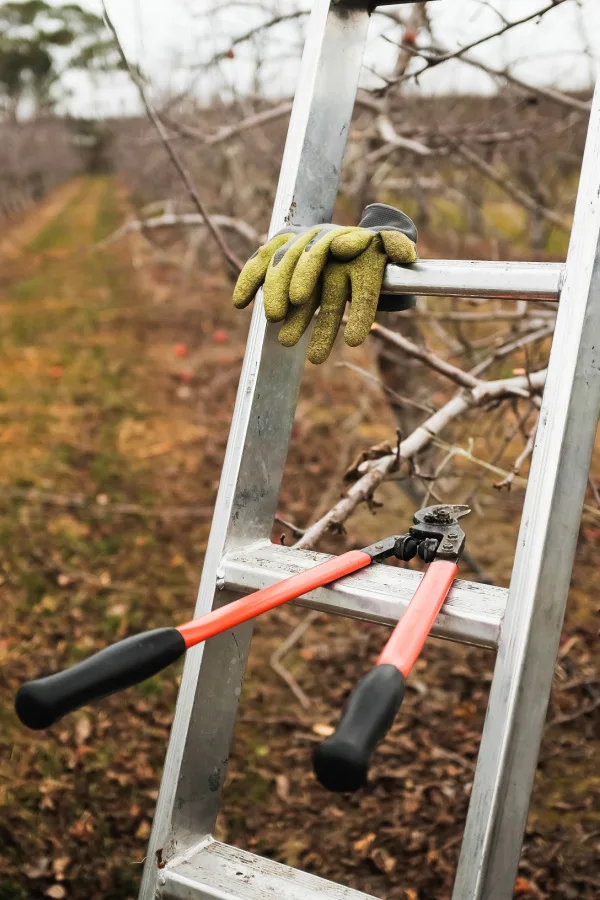
A step stool or ladder is also another important piece of equipment to have on hand. You’ll need it for semi-dwarf and regular-sized fruit trees. Also, don’t forget proper gloves and eye protection as well.
Assess The Tree – Prune Fruit Trees In The Winter
Now that you have the right tools and equipment, it’s time to immediately start pruning, right? Well, not so fast. Chances are, if you just jump right into pruning without a simple plan of attack, you’ll likely end up trimming off way more than the tree really needs.
Just take a couple of minutes to step back and really look at the tree from different angles. Think about which branches you need to prune back and which you want to leave for the new growth in the spring. Also, keep in mind the following two main pruning styles and which one fits your situation.
2 Main Types Of Pruning Styles
There are two main types of fruit tree structures: central leader and open vase/center. You need to prune them differently based on what type of tree they are.
Trees like apples and pears should be pruned to maintain a central leader appearance. The tree will have an overall triangle shape. A thick main branch comes up the middle and several main slightly upright branches come off of it.
Stone fruit, on the other hand, should be pruned with more of an open vase/center shape. Stone fruits include any fruit that has flesh surrounding one large, hard shell with a seed. Peaches, plums, apricots, nectarines, and cherries are all considered stone fruit.
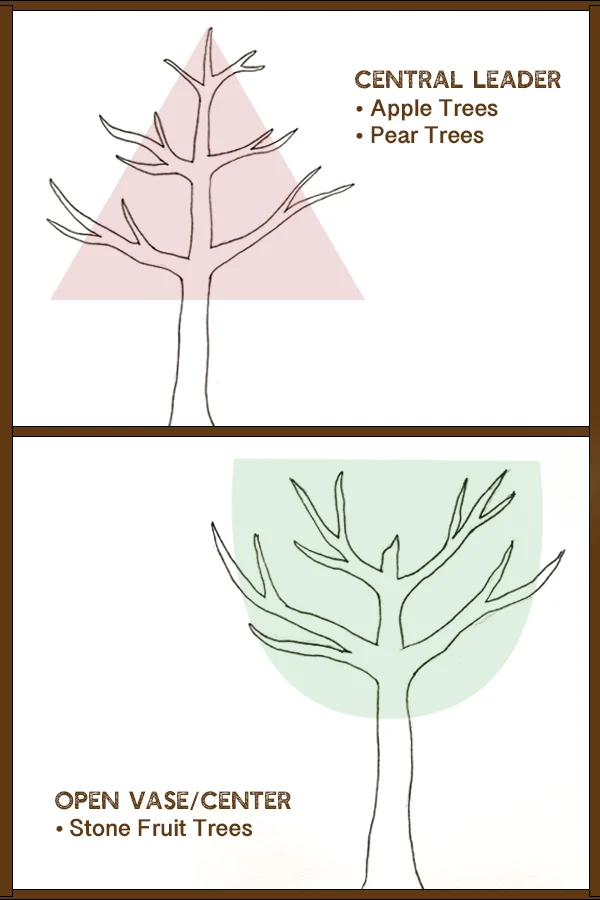
The open vase shape allows more air and sunlight to reach the middle of the tree. Essentially, you are removing the central leader branch at the top and allowing the sides to branch out, creating a slight vase or bowl-like shape.
Ok, now it’s time to start pruning!
Removing Dead Weight – Prune Fruit Trees In The Winter
You should first remove any branches that are broken, damaged, diseased, or dead. Not only do these branches cause the tree to look unsightly, but they can also open the tree up to diseases and issues down the road.
In addition, the tree will continue to send its resources and energy to those damaged branches to try to repair them during the active growing season. Pruning and removing these branches in the winter will allow the fruit tree to send its resources only to where it really counts.
Cut the branches all the way back to the trunk of the tree or to a spot where the damaged branch connects to a larger limb. This will help keep the tree looking tidier. It will also help to prevent new growth from occurring if a small nub was left behind.
Thinning – Prune Fruit Trees In The Winter
The next step is to thin out your fruit tree. As mentioned earlier, fruit trees need to have proper light and air circulation to stay healthy and help prevent diseases from occurring. Your goal with thinning is to open up the tree’s canopy.
Remove any branches that cross paths and might rub against one another. As the wind blows, this will cause friction and eventually damage to the branches, which is a perfect opportunity for diseases and pests to take root.
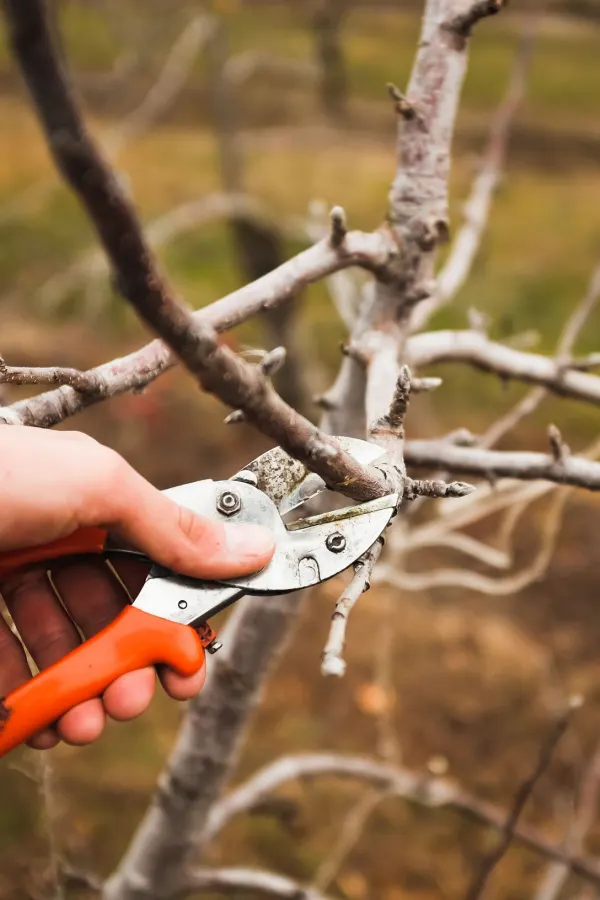
Leave behind the branch that is the healthiest and that is growing in an upward direction for the best result and cut the other. You can either remove the weaker branch in its entirety or cut it back to a location that will allow its new growth to grow unobstructed.
You may also need to remove branches that are growing inwards. Those branches might not be causing issues right now, but as they grow they will.
Lastly, remove any branches that are growing downward or horizontally. These branches will often struggle and are usually the first to break when they are filled with the heavy weight of growing fruit.
New Growth – Prune Fruit Trees In The Winter
The last step in the pruning process is to remove some of last year’s new growth and/or to top or shorten the central leader branch. No matter what shape of pruning you are doing, try not to remove more than a quarter of new growth each year.
Removing some of the new growth helps to strengthen the tree and allows it to fill out properly. Most bud growth occurs on second-year branches, so removing the excess new growth will allow the resources to go to those older branches.
Cleanup – Prune Fruit Trees In The Winter
Finally, now that your fruit trees are properly pruned, you need to clean up all those branches. If you have access to one, using a wood chipper is an excellent way to create free, organic mulch. Wood chips are excellent mulch that you can use around your fruit trees or throughout your garden. Or, consider burning them and using the wood ashes around your garden.
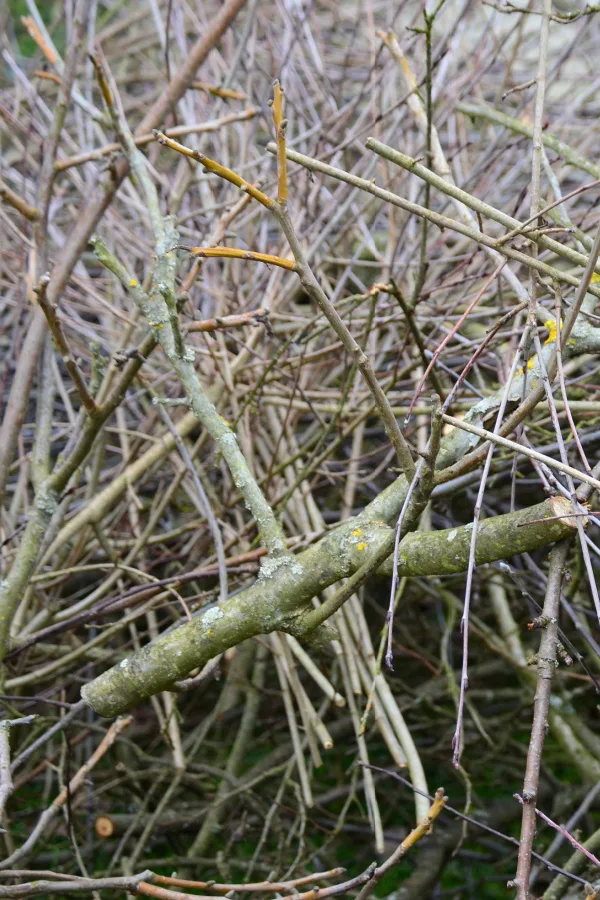
Consider using some of the larger branches for homemade trellises or supports for garden plants. You can make a simple teepee with just a few branches and some string. They make for a perfect home for climbing plants like vining peas.
Another way to use up those branches is to create a natural habitat on the edge of your property for wildlife. Many different creatures and insects can use the pile as a place for shelter or even a food source.
Whatever you decide to do with your branches, you will be rewarded with healthier, strong fruit trees in the spring all because you took a little time to prune them properly during the cold winter months!
Follow Our Facebook Page For Even More Great Tips! Simple Garden Life Facebook Page
Simple Garden Life is a website dedicated to keeping gardening fun, simple and enjoyable! We publish two new articles each week along with a new garden podcast episode every two weeks. This article may contain affiliate links.
